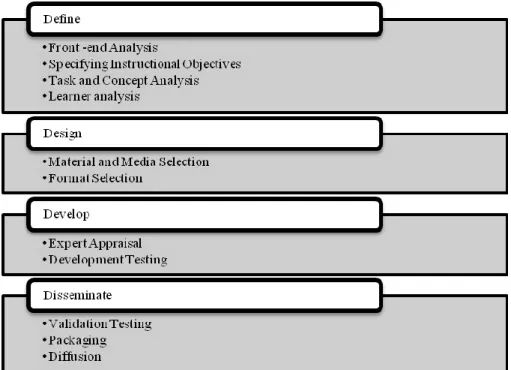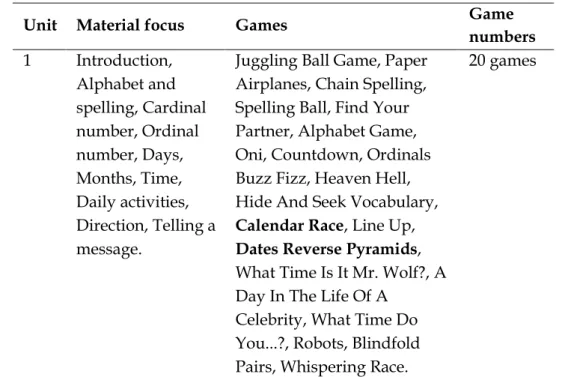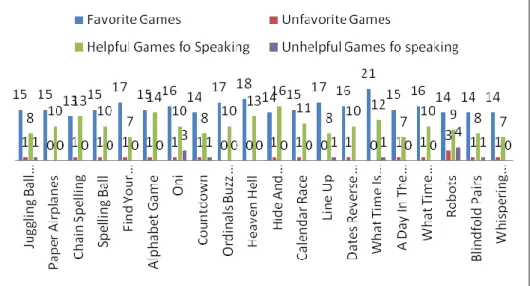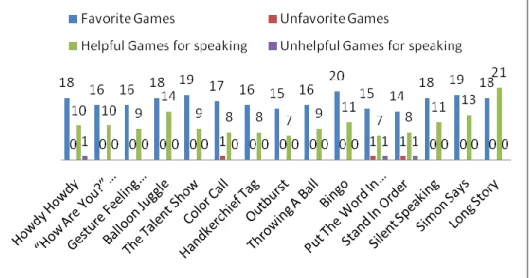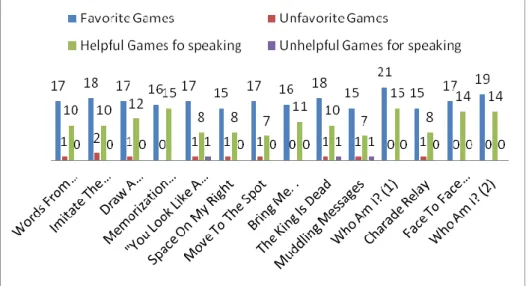13
DEVELOPING LANGUAGE GAMES TO TEACH SPEAKING SKILL FOR INDONESIAN SENIOR HIGH SCHOOL LEARNERS
Ahmad Zubaidi Amrullah
State Islamic Senior High School 2 (MAN 2) Gresik, Indonesia ubed_amrullah@yahoo.com
Abstract: This research aims at developing language games to teach speaking for the students joining English Study club as extra-curricular program at one of the State Islamic Senior High Schools in Gresik, Indonesia. It tries to develop the suitable speaking games and to investigate the students‘ responses toward the developed games. This research and development (R&D) is conducted by adapting Thiagarajan‘s (1974) model called 4D which consists of Defining, Designing, Developing, and Disseminating. The data were gained through interview and questionnaire, and observation checklist. The interview is conducted to study the front-end, specifying instructional objectives, and learner analysis. The questionnaire is employed to do task-concept analysis, to get the students‘ responses, and to submit the experts‘ appraisal. Meanwhile, the checklist is used to conduct development testing. Finally, the product of the study is in the form of a handbook entitled ―A Library of Games‖ which comprises 3 units and 50 kinds of games for teaching speaking skill.
Keywords: language games, speaking skill, English study club
INTRODUCTION
14
schools have started to encourage their students‘ speaking proficiency by having additional programs such as English extracurricular and English club to improve the students‘ speaking skill that they do not obtain in the formal class. Richards and Renandya (in Cahyono and Widiati, 2011, p.29) stated that ―A large percentage of the world‘s language learners study English to develop proficiency in speaking‖.
For many years, games have been regarded as something useless. Nowadays, many research studies are being conducted to investigate the use of games as a technique in the teaching and learning process. Many people believe that learning by playing is considered effective to answer the students‘ boredom over serious, strict, and monotonous study in the classroom. By using games, the students are expected to enjoy their learning process without forgetting the main goal of their study. Games are an amicable way for an educator to present material and assess material learned, in a way that appeals to all her students. Games also help you to maximize each students‘ learning potential. (Sugar, 2002, p.4)
In this study, the researcher develops English language games which are helpful for students to improve their speaking proficiency. The product of this study is a handbook called ―A Library of Games‖ which is used as the guidelines in teaching speaking skill for Indonesian Senior high school students practically. This study was conducted at one of State Islamic Senior High Schools in Gresik, Indonesia, which has an extra English program called Fun English Club (FEC). This program is targeted to the excellent classes in grade X, XI, and XII at first semester only. Each class is exposed to 5 semesters of extra instruction. This club‘s activities are mostly focused on improving the students‘ ability to speak. Nevertheless, the use of grammar lesson is also important to support the students‘ speaking ability. Therefore, both grammar and speaking are introduced first in this club.
15
facts showing that the students face some speaking problems when they communicate each other. One of the problems is that the students‘ ability to speak is still considered to be low. The students often make common errors either on the diction, grammar or pronunciation. In addition, the students often feel reluctant to speak English with their friends. They are too often afraid of making a mistake. Moreover, they often find boredom of studying English. It happens because the FEC class usually begins after the formal school is over. Therefore, the students are already tired after concentrating on the formal lesson. Another problem is that the teachers sometimes find difficulty in energizing the students. They might sometimes use some games in the class but the games they play are still could not answer the students‘ tiredness and boredom in the study. Moreover, the teachers do not have certain guidelines for playing the games. They simply adopt from some sources and apply it to the students without submitting and administering the games to be reused in other occasion.
16 LITERATURE REVIEW
The Nature of Games
One can find numerous definitions of ‗games‘ from dictionaries, and other reference books, in which the concept is basically the same. Hadfield (1999) defined ‗games‘ as activities with rules, a goal, and an element of fun. He added that there are basically two kinds of games; competitive and cooperative. Competitive games are those in which the players or teams race to be the first to reach the goal. Meanwhile, in cooperative games, there are players or teams who work together towards a common goal. Yet, in this research, the writer defines the term ―English games‖ as fun and enjoyable activities which use English as the instructional language and are conducted with some rules to reach a goal. These activities help teachers to create a better teaching-learning process. They could be presented in different ways to the class at the appropriate moment to create a positive atmosphere for learning without thinking about learning. Play is a purposeful activity and games are a part of playing. As such, games are a very appropriate teaching technique in the young-learner class-room (Linse, 2005).
Based on the activities used, Collard (2015) groups games into several types. They are as follows:
1. Ice-Breakers
They are group games and activities which invite to interact in a very fun, non-threatening, and get-to-know-you manner. These activities, including many innovative name games, are guaranteed to ‗break the ice‘ and generate lots of laughter.
2. Energizers, Warm-Ups
17 3. Physical Education Games
These activities are useful as warm-up exercises as much as they generate lots of running around and physical exertion. Emphasis on healthy competition, but include some fantastic elimination games too
4. Team-Building
It is an activity which invites the group to ‗stretch‘ outside their comfort zones a little, with a view to developing critical interpersonal skills such as trust and healthy interaction, ideally sequenced alongside team-building activities to strengthen relationships.
5. Problem Solving
It involves whole group participation, focusing on developing practical group problem-solving, leadership, communication, and teamwork skills. It is ideal for groups of young people and adults, new and existing teams.
6. Puzzles
These games are specifically designed to invite people to think creatively and work together to solve a problem. Generally passive in nature, these fun activities offer many teachable moments. 7. Debriefing
It involves practical strategies, ideas, and activities which will assist to process group‘s experience to facilitate their learning, growth, and development. It emphasizes on communication, new and innovative ideas which inspire lots of teachable moments.
18
variety of tools to facilitate the teaching-learning process, 2) are flexible, 3) make the lesson less monotonous, 4) raise the students‘ motivation, 5) make students produce language subconsciously, 6) stimulate students‘ participation and give them confidence, 7) transform the teacher‘s role from that of formal instructor to that of an organizer or/and moderator of the class, and 8) can also serve as a testing mechanism.
We see that games involve many factors: rules, competition, relaxation, and learning in particular. The main focus of using games in class is to help students learn and have fun. However, to use games in classrooms, it is equally important that before playing, the rules of the games are clearly explained and well understood by the students. There should be only a few, well-explained rules. Demonstrations can also be very helpful since it can help students understand the game and help them follow the rules. Otherwise, they will misunderstand the purpose of the game and they may not get the benefits they should from the game. For the pure sake of survival, it is crucial that you have well-planned lesson in order to maintain a certain level of control in your classroom. Well-planned lessons contain activities where children are interested and stay on task (Linse, 2005)
The Teaching of Speaking in the Indonesian Context
19
students to an English course and so on. Linse (2005) points out that speaking activities are an important part of any young learners‘ ESL and EFL classroom and are often considered the focal point of instruction. When teaching speaking, it is especially important to select activities witch match the objectives of your program.
Due to the current status of English as a foreign language in Indonesia, very few people use it in their daily communication. One can probably find several people speaking English in their daily life such as English students in universities, English courses or in international workplaces such as in a hotel, tourist attractions, and so on. But to find high school students in Indonesia speaking English in their daily life is almost impossible. It happens because the national system of English education does not focus on the students‘ speaking ability. The formal class activities encourage the students to master the ability to read and listen that often referred to as a receptive skill rather than speaking and writing as a productive skill. It is evidence, after reviewing most 2006 curriculum books, which the primary activity is reading and listening. Although several schools have already adopted the 2013 curriculum which emphasizes the students‘ productive skills, it still seems that the teachers continue to do the same activities in the formal class. Moreover, Indonesian students seem to have low motivation toward speaking English. They still keep in mind that speaking is something difficult. They are not accustomed to speaking with their friends, often feel reluctant, and are afraid of making mistakes either in pronunciation, diction or grammar.
20
especially when they are being asked to give personal information or opinions. Frequently, too, there is a worry about speaking badly and therefore losing face in front of their classmates. Another problem is coming from the teachers‘ control over the students. It is hard for the teachers to develop the students‘ speaking skill without supervising them every time. Even the teachers‘ presence at school is not enough to have full control over the students‘ speaking activities.
METHOD Research Design
The research design used in this study was Research and Development (R&D) that was primarily designed to develop the English games to teach speaking for ―Fun English Club‖ students at the Second State Islamic Senior High School of Gresik, East Java, Indonesia. Therefore, the goal of this study was to develop English speaking games for the students of Fun English Club. The final product was developed based on the students‘ need which the researcher investigated in the preliminary studies.
Research Subject
The research was carried in March – June 2015 and took place in a State Islamic Senior High School in Gresik, Indonesia, which run an extra English program called Fun English Club (FEC). The subject of the study was the second semester of XI graders of FEC. The total was 28 students consisting of 3 males and 25 females who have already studied for 4 semesters in that club.
Research Procedures
21
process in accordance with the problems, objectives and the condition of the research. The process is as presented in figure 1.
Figure 1. Development Procedure
Stage 1: Defining Front-end analysis
This analysis was directed towards to the teachers of FEC. Through interview, the researcher gave several questions that reflected the need of English instructional games in the class. This analysis answered the questions whether or not the teachers of FEC needed English instructional games for speaking.
Specifying instructional objectives
22
objectives of each material used. This step was taken in order to notice whether or not the instructional content and activities were practically relevant. In this way, the researcher could consider what the appropriate games were to be applied in order to make better speaking learning atmosphere.
Task and conceptual analysis
These both analyses were designed to help the researcher to identify the activities applied by FEC teachers in teaching speaking class and investigated whether or not the activity models have matched the purpose of the study and the students‘ condition. In this step the researcher used questionnaires subjected to the students.
Learner analysis
In this step the researcher interviewed the students as a way of obtaining the information relating the students‘ speaking capability. The step was intended to reveal the students‘ English speaking capability, problem, and common errors in spoken English.
Stage 2: Designing
Material and Media Selection
23 Format selection
The design format of the product was in the form of printed book called ―A Library of Games‖. The book consisted of several units and each entry of games was presented in the form of procedure text that contained material and equipment, steps and duration. In addition, each entry was completed with material/topic focus, the games‘ categories (energizer, ice breaker, team building etc), the users‘ level, age and the objective that the game is going to achieve. The format of the cover was designed by the researchers‘ colleague who graduated from Information and Communication Technique Department of one University in East Java, Indonesia.
Stage 3: Developing Expert appraisal
This step was required in order to get feedback of the research. The researcher could modify the material to make it better, more appropriate and accurate. The expert appraisal was divided into two domains, they were instructional review that covered appropriateness, effectiveness and feasibility and the domain of technical review consisted of media, format and language. Through questionnaires, the researcher employed three experts. One of them is Indonesian lecturer and two others are American volenteer teachers.
Developmental Testing
24 Stage 4: Disseminating
In dissemination stage, the evaluations of the students‘ response were undertaken. The first evaluation was internal evaluation done by the researcher himself meant to know whether or not each game has already met the criteria determined by the researcher. The games were then modified based on the result of field test. The second evaluation was conducted by the experts by through the similar questionnaires to the step of expert appraisal. It was intended to collect the experts‘ opinion on the instructional and technical quality of developed materials. In this case, experts‘ opinion will not be used to modify the material but to provide the experts‘ objective judgment as a part of the final validation report.
Finally, the researcher tried to publish the final product in order that other teachers can take benefit from the book to improve the quality of teaching activities in exciting ways. The publication steps covered the activities of packaging and diffusion that were accomplished by the publisher.
Research Instrument
In conducting the research, the researcher employed three reseach instruments; interview questions, questionnaires, and observation checklist. The interviews were done with the students in the steps of learner analysis, while the interview with the teachers was conducted in the step of frond-end analysis and specifying instructional objectives. The questionnaires were distributed to the students and the three experts in order to obtain their responses towards the games and to get the appraisals from the experts about the products. Lastly, the observation through checklist was used in development testing to see how each game worked in the field.
Data Collection
25
interview was done with two FEC teachers as a mean of team teaching discussion to find out the basic problem faced by the teachers and students in speaking class, the need of speaking games as well as to get the information about the existing speaking materials, games and their objectives. The second interview was conducted with the students to know their English ability to speak, condition and the need of English speaking games.
To know the tasks and activities given by the teachers in speaking class, the first questionnaire was given to the students. This questionnaire was comprehensively intended to answer whether or not the teachers‘ tasks and activities already matched the students‘ need. The second questionnaire was subjected to the experts to gain the appraisal of the experts. This way was taken in order to get a good feedback and suggestion for the betterment of the research and product. The next questionnaire was presented to the students to know the responses of the students toward English games. Finally, the last questionnaire was presented to get the experts‘ opinion about the final product.
The researcher used observation to understand about the condition of the students and the process of the activities in the field test. The observation was done by observation checklist.
Data Analysis
26 FINDINGS AND DISCUSSION
Findings
The Developed Language Games
The developed product was in the form of a printed book which was called ―A Library of Games‖ containing several types of instructional games. The games were mainly aimed at improving the students‘ speaking proficiency. The book comprised of 3 units and each unit was presented in the form of procedure text that contained materials, equipment, steps and suggestions. In addition, each game entry was written in procedure text which explained the topic, the English proficiency level and age of students, needed materials, the objectives, duration and the ―how to‖ for that particular game. Furthermore, it was completed with appendices of media to play the games at the end of the book section.
Table 1 Division of Book Units
Unit Material focus Games Game
numbers
1 Introduction,
Alphabet and spelling, Cardinal number, Ordinal number, Days, Months, Time, Daily activities, Direction, Telling a message.
Juggling Ball Game, Paper Airplanes, Chain Spelling, Spelling Ball, Find Your Partner, Alphabet Game, Oni, Countdown, Ordinals Buzz Fizz, Heaven Hell, Hide And Seek Vocabulary,
Calendar Race, Line Up,
Dates Reverse Pyramids,
What Time Is It Mr. Wolf?, A Day In The Life Of A
Celebrity, What Time Do You...?, Robots, Blindfold Pairs, Whispering Race.
27
2 Greeting, Asking
condition, Quiz, Talent, Color, Vocabulary, Sentence, Puzzle, Command, Story.
Howdy-Howdy, ―How Are You?‖ Gesture Game, Gesture Feeling Race, Balloon Juggle, The Talent Show, Color Call,
Handkerchief Tag, Outburst, Throwing A Ball, Bingo, Put The Word In Order, Stand In Order, Silent Speaking, Simon Says, Long Story.
15 games
3 Describing a
picture,
Instruction, Look/ look like,
Invitation, Telling a story, Listening comprehension, Describing a person, Interrogative sentence, TV programs, Interview, Discussion, Yes/no question, Telling identity.
Words From Pictures, Imitate The Picture/Photo, Draw A Picture/Write A Story, Memorization Game, "You Look Like A Monkey" Gesture Game, Space On My Right, Move To The Spot, Bring Me. ., The King Is Dead, Muddling Messages, Who Am I?, Charade Relay, Face To Face Interviews, Who Am I?, The Shoe Game.
15 games
28
for example: foreign aid organizations, large Multinational Corporation, red cross, etc. furthermore, It has great applicability.
Students’ Response towards English Speaking Game
Researcher acquired very positive responses from FEC students. Although the development testing was carried in the examination week, but the students‘ spirit to play the game was excellent. At the end of development testing, the researcher went on distributing the questionnaires to the students to submit their responses toward the games they have played. The questionnaire mainly investigated the student‘s responses about the preferred games and helpful games for speaking based on the students‘ version. The discussion is presented in each Unit and the result is as follows.
Figure 2. Sudents' Response on Games in Unit 1
29
students‘ speaking skill in this unit was ―Hide and Seek Vocabulary‖ since it gained 16 score of the students or about 72,7%.
Figure 3. Students' Responses about Games in Unit 2
From Unit 2 in the figure 3, the researcher could see that the most preferred game for the students was ―Bingo‖. 20 or about 90,9% of the students favored it so much. And the most helpful game for them was ―Long Story‖. It gained 21 students or about 95,5%.
30
Figure 4. Students' Responses on Games in Unit 3
Discussion
A book called ―A Library of Games‖ that was developped with Four-D Model by Thiagarajan (1974) represented that there was a great passion of Indonesian students to learn English by playing. The games were submitted based on the speaking materials taught in Fun English Club. The speaking materials were divided into three levels, they were basic materials which were targeted for the 10 graders, intermediate for 11 graders and advanced level for 12 graders of the odd semester. These games are categorized into nine types as mentioned by Collard (2015), they were Ice-Breakers, Energizers/Warm-Ups, Physical Education Games, Team-Building, Problem Solving, Puzzles and Debriefing. Neverthless, it was possible for a certain game to have more than the above types. Since, it possessed their typical characters when practically played. Some typical games were also completed with the copiable media for playing them.
31
provided an opportunity for students to use their language in a less formal situation, without the pressure of speaking in perfect form, but with the enthusiasm for winning the game, as well as practicing the language. The three figures in the findings displayed a very significant preference of the students on certain games. Such as seen in the Unit 1, ―What time is it Mr. Wolf?‖ Became the students‘ favorite game. This game‘s objective was to enable students to know how to ask and tell the time. It was best played by intermediate students. The games‘ categories were Ice Breaker, Energizer, Physical Education and Debriefing. They liked this game as it involved concentration and physical action. Here, the students were invited to learn how to ask and tell the time correctly in a different and fun way without forgetting the main goal of the study. And however, It was in line with the objectives of ―A Library of Games‖ which were:
1. To provide English instructional games for teaching and encouraging speaking in class.
2. To be a reference for the teachers with games suited for students‘ abilities, age and topics to be taught.
3. To bring fun into English class without forgetting the goal of the lesson, Increase the students‘ motivation, creative thought and team work. This goal also applies to group facilitators presenting in English.
To help teachers or group facilitator to use, adapt, modify or invent games.
32 CONCLUSION
The researcher finally arrived at the conclusion of the entire process of the research. There are two conclusions that the researcher is going to present. First, the suitable games to teach speaking for Fun English Club students were the games whose objectives were in line with the materials existing in Fun English Club. Nevertheless, the students‘ game category preference was necessarily paid attention in order to make the game application more attractive. Therefore, the researcher thought that the 50 games which exist in ―A Library of Games‖ handbook were the most suitable games since they provide equal objectives and answer the students‘ preference. Second, the handbook entitled ―A Library of Games‖ which was developed using Thiagarajan‘s model (1974) gained various positive responses from the students. However, the most responses which were seen in the questionnaire result of development testing showed that most of the students were interested in playing the games, enjoyed the whole activities, learnt from each other, and expected to play the games again. It indicated that most of the students expressed their good responses towards the English instructional games to teach speaking that the researcher was developing.
REFERENCES
Cahyono, B. Y., & Widiati, U. (2011). The Teaching of English as a Foreign Language in Indonesia. Malang: State University of Malang Press.
Collard, M., (2015). Activity Categories. Retrieved on February 20, 2015 from http://www.playmeo.com/category
Hadfield, J. (1999). Intermediated Vocabulary Games. Harlow: Longman.
Harmer, J. (2007). The Practice of English Language Teaching 4th Edition.
33
Linse, C.T. (2005). Practical English Language Teaching: Young Learners. New York: McGraw-Hill.
Sanchez, M.M.M., Morfin, A.P., & Campos, V.E.P., (2007). Interactive Games in the Teaching–Learning Process of a Foreign Language, Teoria Praxis. 4, 46-47.
Sugar, S., & Sugar, K.K. (2002). Primary Games: Experiential Learning Activities for Teaching Children K-8. San Francisco: Jossey-Bass.
Sugiyono. (2012). Metode Penelitian Kuantitatif, Kualitatif dan R&D. Bandung: Alfabeta.
